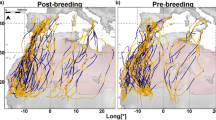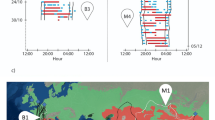Abstract
THE experience gained from flights on aëroplanes and from the behaviour of airships may throw some light on why migratory birds follow certain routes. Pilots in aëroplanes can easily see rivers and ponds, and these form better guides than roads and railways; main roads, now usually tar-coated, are not conspicuous, while the lighter coloured by-roads are more easily seen. There is evidence that migration routes are often along coast lines and river valleys; these are most conspicuous features in an uninhabited country, and birds when flying in the daytime below the clouds could have no difficulty in following them by sight.
This is a preview of subscription content, access via your institution
Access options
Subscribe to this journal
Receive 51 print issues and online access
$199.00 per year
only $3.90 per issue
Buy this article
- Purchase on Springer Link
- Instant access to full article PDF
Prices may be subject to local taxes which are calculated during checkout
Similar content being viewed by others
References
Report on Eight Balloon Ascents in 1862 by James Glaisher, F.R.S. B.A. Report, 1862, p. 490.
See Papers on Mechanical and Physical Subjects by Osborne-Reynolds, F.R.S., pp. 89 and 157.
Certain carnivorous birds have their eves more in front; birds follow the same general rule as other animals; the eyes of the hunter are in front which must help him to see his prey, and the eyes of the hunted are at the side of the head to enable him to watch his pursuer.
Rights and permissions
About this article
Cite this article
DARWIN, H. Migration Routes . Nature 92, 370–371 (1913). https://doi.org/10.1038/092370b0
Issue Date:
DOI: https://doi.org/10.1038/092370b0
Comments
By submitting a comment you agree to abide by our Terms and Community Guidelines. If you find something abusive or that does not comply with our terms or guidelines please flag it as inappropriate.



